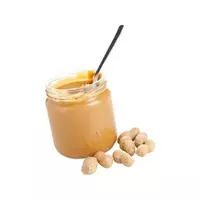Peanut paste

Often, many people get confused in the names of two related, but nevertheless completely different products - peanut butter and peanut butter. This is probably because in English the phrase Peanut butter, which appears on cans of this product, means Peanut butter. But butter is not a product of liquid consistency, but of animal origin of a dense creamy structure, that is, butter. And the healthy peanut butter, which is used mainly in frying foods, is called Peanut oil.
Interestingly, today there is more than one type of peanut paste, each of which depends on the duration of grinding the nut mass. You can find a product with the addition of candied fruits, crushed nuts, coconut chips, a lightweight creamy version, as well as a paste without sugar and salt. The beneficial properties of peanut paste and its high nutritional content are highly appreciated all over the world. For example, according to statistics, about 40 million people living in the United States eat peanut pasta every day.
Traditionally, peanut butter is usually used as a delicious spread on toast or a piece of fresh white bread, and then consumed with tea, milk, cocoa or coffee. In America, for example, peanut butter and jelly sandwiches are especially popular. For culinary purposes, it is often used in the preparation of a variety of pieces and cookies. In addition, you can add this paste to sauces and risotto, as well as cream (for cakes and cakes) to give the finished dishes a nutty taste. The calorie content of peanut paste is 598 kcal per hundred grams.
Peanut butter composition
But what is the real peanut paste? This product, which is completely ready to eat, is a mixture of peeled, roasted and then crushed peanuts, a small amount of sugar and salt, as well as vegetable oil. In addition, stabilizers for a more stable product structure are often added to the peanut paste composition.
High-quality peanut paste is characterized by a uniform creamy consistency with a smell and taste that are inherent in the fried kernels of earthnut. The color of the product can range from pale brown (almost cream) to a rich coffee hue. This directly depends on the composition of the peanut paste and how it is made.
The benefits of peanut butter
The benefits of peanut butter lie in its high nutritional value. This nut product has a considerable satiety index due to the content of dietary fiber and protein, therefore it is able to reduce hunger. It has been proven that if you consume this pasta for breakfast, you want to eat much less throughout the day.
However, in order for the benefits of peanut paste not to turn into harm, the measure should be observed when eating it. So, it is recommended not to exceed the daily norm of 30 grams, which corresponds to one tablespoon of the product.
Peanut butter harm
Speaking of the possible unpleasant consequences and harm of peanut paste, it should be remembered that this is a very high-calorie product due to its considerable fat content. Therefore, nutritionists unanimously do not advise people prone to obesity, as well as patients with gout, arthritis and arthritis, to indulge themselves with this treat.
peanut paste 598.15 kCal
Energy value of peanut paste (Ratio of proteins, fats, carbohydrates - ju):
Proteins: 24.81 g (~ 99 kCal)
Fats: 50.55 g. (~ 455 kCal)
Carbohydrates: 10.37 g (~ 41 kCal)
Energy ratio (b | y): 17% | 76% | 7%
 Español
Español Français
Français Português
Português Русский
Русский 简体中文
简体中文 繁體中文
繁體中文 日本語
日本語 한국어
한국어 العربية
العربية Türkçe
Türkçe Қазақ
Қазақ Deutsch
Deutsch Italiano
Italiano Українська
Українська
